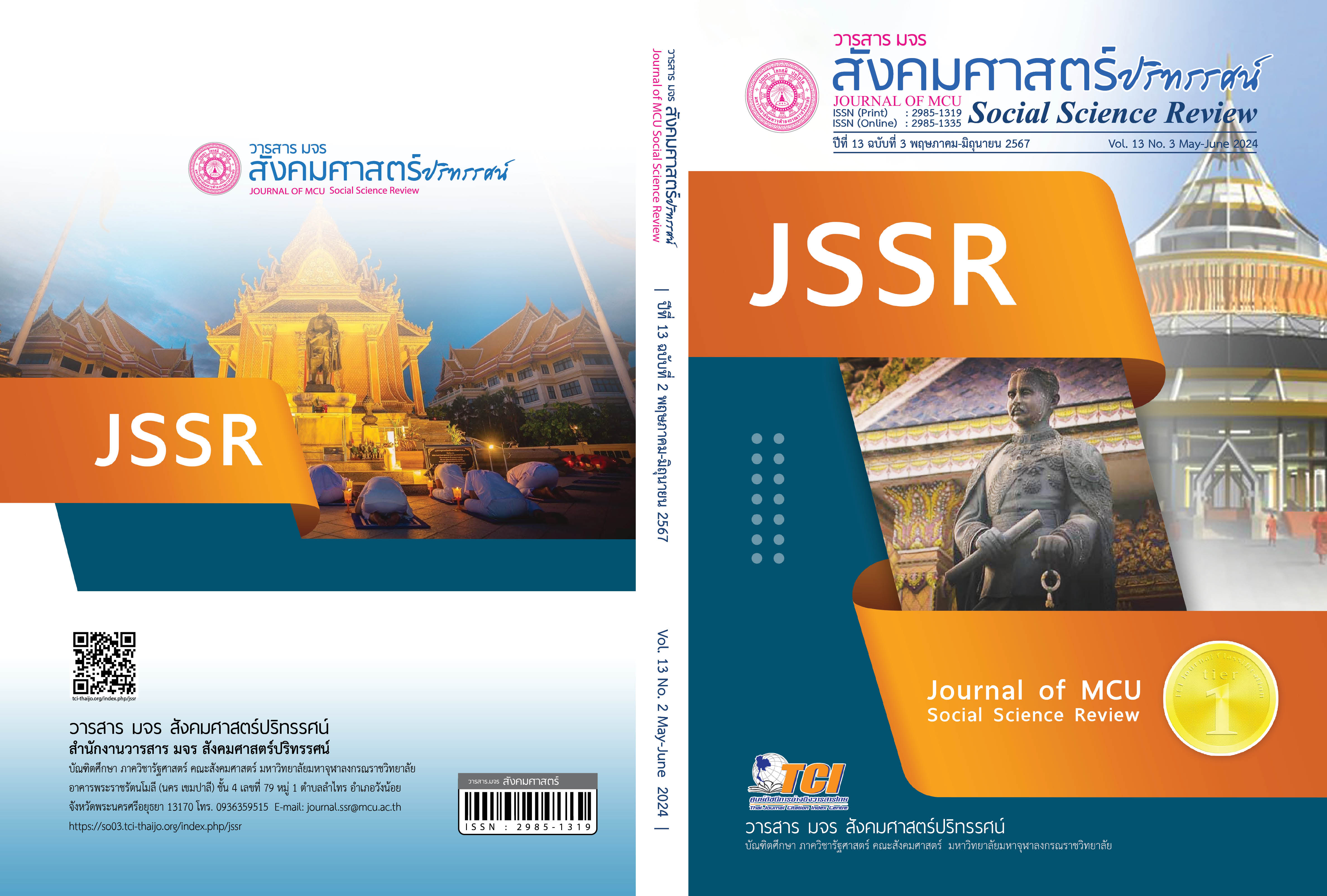ระเบียงเศรษฐกิจตะวันออก-ตะวันตก (East-West Economic Corridor) ที่มีผลกระทบต่อการยกระดับศักยภาพการแข่งขัน ของกลุ่มธุรกิจขนส่ง SMEs ไทย
คำสำคัญ:
ระเบียงเศรษฐกิจตะวันออก-ตะวันตก, การยกระดับ, ศักยภาพการแข่งขัน, ผลการดำเนินงาน, ธุรกิจขนส่ง SMEs ไทยบทคัดย่อ
บทความวิจัยนี้มีวัตถุประสงค์ 1. ศึกษาปัจจัยองค์ประกอบของความสามารถในการแข่งขันที่มีต่อผลการดำเนินงานของธุรกิจขนส่ง SMEs บนเส้นทางระเบียงเศรษฐกิจตะวันออก-ตะวันตก และ 2. ศึกษาระดับขั้นการปรับตัวการดำเนินงานของกลุ่มธุรกิจขนส่งบนเส้นทางระเบียงเศรษฐกิจตะวันออก-ตะวันตก เป็นการวิจัยแบบผสม โดยการวิจัยเชิงปริมาณใช้แบบสอบถาม มีคุณภาพด้านความตรงเชิงเนื้อหา (IOC) ระหว่าง 0.30 -1.00 ค่าความเชื่อมั่นทั้งฉบับเท่ากับ 0.914 และค่า KMO เท่ากับ 0.79 เก็บข้อมูลผู้ประกอบการขนส่งในพื้นที่เขตภาคเหนือตอนล่าง จำนวน 150 ราย ด้วยวิธีการสุ่มตัวอย่างแบบหลายขั้นตอน วิเคราะห์ข้อมูลโดยหาค่าความถี่ ค่าร้อยละ ค่าเฉลี่ย ส่วนเบี่ยงเบนมาตรฐาน การวิเคราะห์สมการเชิงโครงสร้างแบบ PLS-SEM และการวิจัยเชิงคุณภาพ ใช้วิธีการสัมภาษณ์เชิงลึก ผู้ประกอบการขนส่ง SMEs
ผลการวิจัยพบว่า 1. ปัจจัยองค์ประกอบของความสามารถในการแข่งขันที่มีผลต่อการดำเนินธุรกิจขนส่ง ได้แก่ ขนาดกิจการ ระยะเวลา ต้นทุน คุณภาพบริการนโยบายของประเทศเพื่อนบ้าน นโยบายของรัฐบาล ภาวะการณ์แข่งขันภายในประเทศ ภาวะกดดันลูกค้า ส่งผลต่อการปรับตัวการดำเนินธุรกิจขนส่งในขั้นตระหนักรู้ ขั้นสนใจ และขั้นทดลอง และส่งผลต่อผลการดำเนินธุรกิจขนส่ง ได้แก่ รายได้ กำไร ส่วนแบ่งตลาด และประสิทธิภาพเพิ่มขึ้น 2. ระดับขั้นการปรับตัวการดำเนินงานของกลุ่มธุรกิจขนส่งบนเส้นทางระเบียงเศรษฐกิจตะวันออก-ตะวันตก ด้านการปรับตัวการดำเนินงานของกลุ่มธุรกิจขนส่ง พบว่า ผู้ประกอบการมีการปรับตัว ตระหนักรู้ว่าการขนส่งบนเส้นทางระเบียงเศรษฐกิจตะวันออก-ตะวันตก มีผลดีต่อธุรกิจขนส่ง
เอกสารอ้างอิง
ขวัญชนก อำภา และวันชาติ ชาญวิจิตร. (2564). การพัฒนาเส้นทางระเบียงเศรษฐกิจแนว ตะวันออก-ตะวันตกกับกระบวนการวางแผนแบบรวมพลัง. วารสารมหาวิทยาลัยราชภัฏร้อยเอ็ด, 2(1), 1-14.
ธนัตถ์ภัทร ถิรธนัชดิลก. (2562). การศึกษาการจัดการขนส่งของธุรกิจขนส่งขนาดกลางและขนาดเล็กในจังหวัดชลบุรี. การประชุมวิชาการระดับชาติ SMARTS ครั้งที่ 9. กรุงเทพฯ: มหาวิทยาลัยศรีนครินทรวิโรฒ.
ธนาคารแห่งประเทศไทย. (2565). สรุปประมาณการเศรษฐกิจและเงินเฟ้อในรายงานนโยบาย การเงิน ธันวาคม 2564. สืบค้น 13 มกราคม 2565, จาก https://shorturl.asia/Njd03
นิตยา สุภาภรณ์. (2564). ความสามารถและความได้เปรียบทางการแข่งขันของผู้ประกอบการวิสาหกิจขนาดกลางและขนาดย่อม (SMEs) ในจังหวัดนนทบุรี. วารสารวิชาการวิทยาลัยสันตพล, 7(2), 43-52.
รณรงค์ พูลพิพัฒน์. (2565). จับชีพจรโลจิสติกส์ไทย. สืบค้น 14 สิงหาคม 2565, จาก http://www.tpso.moc.go.th/th/node/11480
วรวุฒิ จำลองนาค และทวีศักดิ์ ตั้งปฐมวงศ์. (2557). ผลจากการพัฒนาเส้นทางระเบียงเศรษฐกิจตะวันออก-ตะวันตกต่อการจัดการพื้นที่การค้าชายแดนจังหวัดมุกดาหาร. วารสารมนุษยศาสตร์และสังคมศาสตร์, 2(1), 1-14.
วันรักษ์ มิ่งมณีนาคิน. (2549). เศรษฐศาสตร์ระหว่างประเทศ (พิมพ์ครั้งที่ 10). กรุงเทพฯ: จุฬาลงกรณ์มหาวิทยาลัย.
วีรชัย งามจรัสศรีวิชัย. (2561). การพัฒนาขีดความสามารถในการแข่งขันของประเทศจากโครงการท่าเรือน้ำลึกทวาย. วารสารสหวิยาการวิจัย มหาวิทยาลัยกรุงเทพธนบุรี, 7(1), 131-137.
Anderson. (1993). The internationalization process of the firm: A model of knowledge development and increasing foreign market commitments. Journal of International Business Studies, 8(1), 1-21.
Chin, W. W. (1998). The partial least squares approach for structural equation modeling. In G. A. Marcoulides (Ed.), Modern methods for business research, Lawrence Erlbaum Associates Publishers.
Coase, R. H. (1937). The Nature of the Firm. Economica, 4(16), 386-405.
Field, A. (2005). Discovering statistics using SPSS (2nd ed.). Thousand Okes CA: Sage.
Hair, J. F. et al. (2014). Multivariate data analysis (7th ed.). US: Pearson Education Limited.
_____. (2017). A Primer on Partial Least Squares Structural Equation Modeling (PLS-SEM) (2nd ed.). California: SAGE Publications, Inc.
Johanson & Wiedersheim-Paul. (1975). The internationalization of the firm-Four Swedish cases. Journal of Management Studies, 12(3), 305-322.
Kaiser, H. F., & Rice, J. (1974). Little jiffy mark IV. Educational and psychological measurement, 34(1), 111-117.
Nunnally, J. C. (1978). Psychometric theory (2nd ed.). New York: McGraw-Hill.
Porter, M. E. (1990). Competitive strategy. New York: Free Press.
Wickramasekera, R. & Oczkowski, E. (2006). Stage models re-visited: A measure of the stage of internationalization of a firm. Management International Review, 46(1), 39-55.
ดาวน์โหลด
เผยแพร่แล้ว
รูปแบบการอ้างอิง
ฉบับ
ประเภทบทความ
สัญญาอนุญาต
ลิขสิทธิ์ (c) 2024 วารสาร มจร สังคมศาสตร์ปริทรรศน์

อนุญาตภายใต้เงื่อนไข Creative Commons Attribution-NonCommercial-NoDerivatives 4.0 International License.
เพื่อให้เป็นไปตามกฎหมายลิขสิทธิ์ ผู้นิพนธ์ทุกท่านต้องลงลายมือชื่อในแบบฟอร์มใบมอบลิขสิทธิ์บทความให้แก่วารสารฯ พร้อมกับบทความต้นฉบับที่ได้แก้ไขครั้งสุดท้าย นอกจากนี้ ผู้นิพนธ์ทุกท่านต้องยืนยันว่าบทความต้นฉบับที่ส่งมาตีพิมพ์นั้น ได้ส่งมาตีพิมพ์เฉพาะในวารสาร มจร สังคมศาสตร์ปริทรรศน์ เพียงแห่งเดียวเท่านั้น หากมีการใช้ภาพหรือตารางหรือเนื้อหาอื่นๆ ของผู้นิพนธ์อื่นที่ปรากฏในสิ่งตีพิมพ์อื่นมาแล้ว ผู้นิพนธ์ต้องขออนุญาตเจ้าของลิขสิทธิ์ก่อน พร้อมทั้งแสดงหนังสือที่ได้รับการยินยอมต่อบรรณาธิการ ก่อนที่บทความจะได้รับการตีพิมพ์ หากไม่เป็นไปตามข้อกำหนดเบื้องต้น ทางวารสารจะถอดบทความของท่านออกโดยไม่มีข้อยกเว้นใดๆ ทั้งสิ้น





